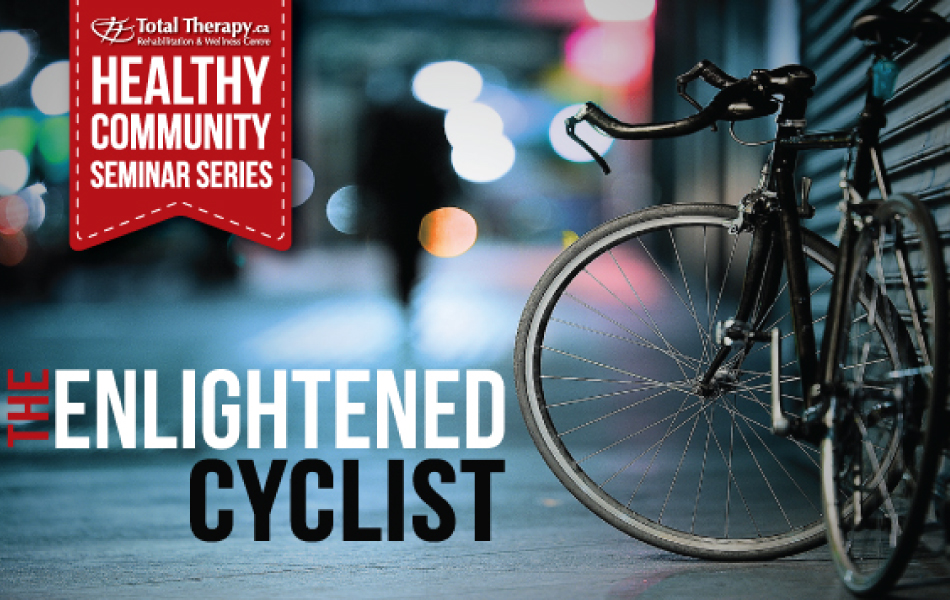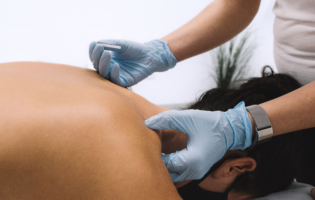Total Therapy Blog

Healthy Community Seminar – The Enlightened Cyclist

This article was contributed by Jordy Shumay. Jordy is Registered Kinesiologist with the BC Association of Kinesiologists. He has a Bachelor of Kinesiology from the University of Calgary, as well as a Masters of Science in Kinesiology from A. T. Still University of Health Sciences.
“Determining an appropriate level of fitness and functionality for my clients is paramount to helping them achieve optimal movement patterns. The methods used to improve weaknesses, imbalances, or correct dysfunctions is accomplished through dedication to research, development, and application of the most current scientifically-based practices. Returning my clients to fully functional movements and beyond is the ultimate goal.” – Jordy Shumay, BKin
Cycling is a great form of exercise for anyone interested in staying fit and healthy. Cyclists come in many forms, from competitive athletes to the weekend warrior. Whatever your end goal or purpose is for taking your bike out for a spin, you should understand what your body is going through in such an activity. Maximizing efficiency of your pedal stroke to promote optimal performance as well as limiting any discomfort that may arise from time spent on your bike will ultimately be achieved by understanding how your body functions while you are riding.
 Before the rubber hits the pavement, you should ensure that your bike properly fits your individual body type to ensure the highest biomechanical efficiency. This service should be performed by a professional bike fitting specialist to guarantee accuracy of the bike setup. Once your bike is correctly set to your body measurements it is time to take your bike to the street.
Before the rubber hits the pavement, you should ensure that your bike properly fits your individual body type to ensure the highest biomechanical efficiency. This service should be performed by a professional bike fitting specialist to guarantee accuracy of the bike setup. Once your bike is correctly set to your body measurements it is time to take your bike to the street.
The lower body muscles that are mostly involved during a standard ride by many cyclists are the quadriceps. This muscle group is largely the first place of fatigue mentioned by most everyday cyclists. This is caused by the repetitive downward pushing motion on the pedal. If you are someone who is a serious enough cyclist, you may have what are referred to as bike ‘clips’ on your pedals, which allow for your bike shoe to be attached to your pedal itself. This piece of equipment more than doubles the amount of work your leg muscles can perform during a pedal stroke by involving the gluteal and hamstring muscle groups during the upward pull phase of the stroke.
 Although the primary focus of cycling is intuitively on the lower body muscles, the entire body is utilized to propel the bike forward. Good posture and strong core musculature place the body in an optimal position in the saddle to produce powerful, yet efficient revolutions of the pedals. Avoiding the tendency to round the shoulders over your handle bars by pulling your shoulder blades into correct position is one easy way to ensure your body is in the right position.
Although the primary focus of cycling is intuitively on the lower body muscles, the entire body is utilized to propel the bike forward. Good posture and strong core musculature place the body in an optimal position in the saddle to produce powerful, yet efficient revolutions of the pedals. Avoiding the tendency to round the shoulders over your handle bars by pulling your shoulder blades into correct position is one easy way to ensure your body is in the right position.
Now that you have an idea what is occurring throughout your body while you are cycling and what muscles are involved, you can understand the importance of strengthening such areas. Improving muscular endurance of the major lower body, postural, and core muscle regions will inevitably enhance your cycling performance and likely prevent any discomfort associated with this prolonged, repetitive sport.








Follow Us!
& Stay Up To Date
BLOG